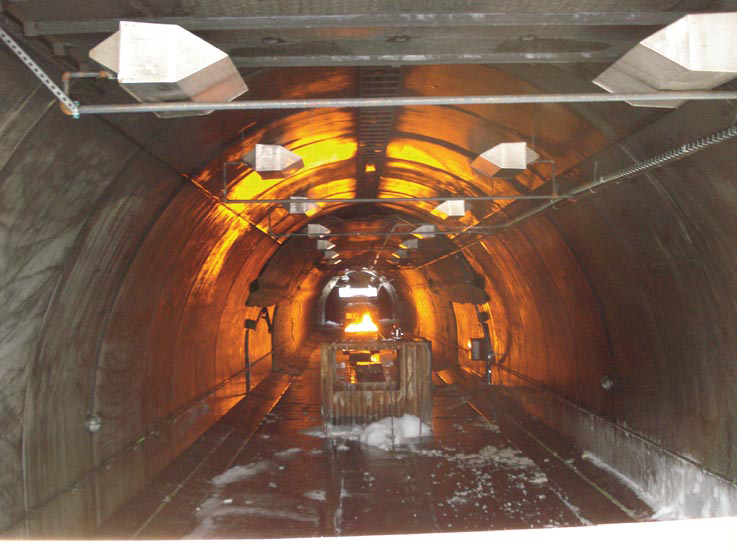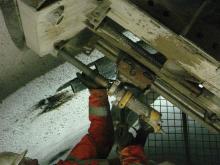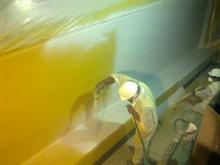Tunnels are the highest value assets on a highway, making their operation, safety and maintenance of paramount importance. Patrick Smith reports

Tyco Safety Products carries out a fire test in a tunnel
Tunnels are the highest value assets on a highway, making their operation, safety and maintenance of paramount importance. Patrick Smith reports
Faced with the many challenges associated with the construction and operation of road and rail tunnels, organisations are often presented with a choice between imitation and innovation.According to BHR Group, tried and tested methods may offer a predictable option but innovation can lead to significant benefits in terms of build and running costs.
"The wealth of experience and knowledge built up by the industry over many years can make this choice extremely difficult, especially at present when there are not inconsiderable economic and cost pressures," says BHR Group, a leading centre of expertise in engineering with fluids, which has performed contract research, development and consultancy for international clients since 1947.
The organisation recently completed its 13th International Symposium on Aerodynamics and Ventilation of Vehicle Tunnels (sponsored by
These were debated as government stimulus packages and private investors worldwide are being called on to instigate some impressive tunnel schemes.
For example, in Vietnam investors are being asked by the Construction Department to invest in a tunnel project in the province of Thai Nguyen. It will be built through the Tam Dao Mountain in the district of Dai Tu and the townlet of Tam Dao, and will be carried out under a wholly foreign-invested, joint venture, build-operate-transfer or build-transfer basis, while a US$348.8 million extension of the so-called Frankenschnellweg motorway in Nuremberg, Germany, will include a 1.8km tunnel. It is expected to be implemented from mid-2010 at the earliest. In another German city Leipzig,
The authorities in New Zealand are inviting companies to tender for the tunnel project in Victoria Park, Auckland. The US$243.34 million project is for the construction of a three-lane tunnel to carry traffic northbound. The start of the construction work is being brought forward ten months to start in January 2010, with completion scheduled for January 2011.
Meanwhile, in Brisbane, Australia, breakthrough has been achieved by
Integritank HF membrane
According toVarious forms of waterproofing techniques have long been used to protect civil engineering structures, with varying degrees of success: if it becomes a requirement to undertake remedial works to the waterproofing because it proves to have an inadequate life span or does not perform as well as had been expected, the potential disruption and ease of carrying out this work will vary greatly depending on the type of structure. Tunnels are the extreme case, says the company.
"Tunnels are the highest value assets on a highway structure and have the longest design life so protecting their long-term integrity should be at the top of the list in the design criteria."
For example, an immersed tube tunnel, which has been waterproofed externally, cannot practically have effective, large-scale repairs carried out to its waterproofing once it has been submerged. Cut and cover tunnels present the same issue, and in bored tunnels of the New Austrian Tunnelling Method (NATM) or Sprayed Concrete Lined (SCL) design, the issue is acute because the waterproofing membrane is installed between the primary and secondary concrete linings, which means that there is no opportunity for maintenance to the waterproofing.
Over the last 30 years throughout the construction industry there has been a significant shift away from sheet systems to the use of sprayed membranes for waterproofing: the use of spray applied liquid membranes reduces the number of seams to zero and thus substantially reduce the risk of leaks, says Stirling Lloyd. Seamless waterproofing technology has benefited many structures, says Stirling Lloyd, which has specialised in the design, manufacture and application of high performance waterproofing membranes for almost 40 years.
However, utilising its experience, Stirling Lloyd's recent focus has been to provide a solution for the internal waterproofing of tunnels, and to develop a new product specifically for the SCL/NATM construction method.
Working closely with major tunnel builder Morgan Est in the UK, the result of this work has been a new spray applied waterproofing membrane, Integritank HF, which will officially be launched at the Rapid Excavation and Tunnelling Congress (RETC) in Las Vegas, USA, in June.
The membrane is based on the advanced methacrylate technology behind Stirling Lloyd's extensively used waterproofing systems, which has been adapted specifically for use in confined spaces and for application between primary and secondary concrete linings.
The spray applied, two-coat system ensures a seamless finish and eliminates the chance of leaking through any seams. The membrane is fully bonded to both primary and secondary concrete linings and therefore water cannot circulate around the structure between the waterproofing and the concrete layers.
Retexture for landmark Welsh tunnels
The
By rehabilitating the existing surface without using remedial materials, the Klaruwtex190 process is said to eliminate the costs and minimise the carbon footprint involved with the quarrying, processing, transport and heat-reliant application of overlay solutions, as well as disposal of worn overlay.
The process has been used on road sections through the A55's three landmark tunnels: the 660m long Penmaenbach tunnel; the 930m long Pen-y-Clip hard rock tunnel, and the 1,060m Conwy Estuary Crossing, Britain's first immersed tube road tunnel at the time of its completion in 1991.
Electrotechnical infrastructure
In a separate development, French group Cegelec, an international group providing technological services to companies and public authorities, is carrying out the electrotechnical infrastructure of the Elbe road tunnel in Hamburg, Germany, one of the longest underwater tunnels in the world (3.3km) used by up to 150,000 vehicles/day.It is understood that four major companies, are involved in the project: German companies HC Hagemann and August Prien (Arge Ingenieurbau) for the building works; Lindner for fire protection and asbestos abatement, and Cegelec for all tunnel techniques such as air ventilation, with New Zealand company SmartStud supplying road marker guidance systems.
Cegelec, which will also equip four tunnels (total length 4.7km) in Algeria, North Africa, on the 1,216km East-West Motorway, will renovate all the electrotechnical infrastructure for three tubes, including ventilation and safety equipment and the traffic management system. Inaugurated in 1975, the Elbe Tunnel comprises four tubes, with the more recently added fourth tube already fitted out by Cegelec, which has its international competence centre in Lyon, France, specialising in tunnel safety equipment.
Florence and Waltzing Matilda in Brisbane
The main roads leading into the centre of Brisbane, Australia, are gridlocked at peak traffic times because the Brisbane River, which divides the city, can only be crossed by bridges.
To overcome this, the city is building a 6.8km tunnel system beneath river (to be completed in 2010). Known as the Clem Jones Tunnel (CLEM7), the Father of modern Brisbane, the Aus$2.2 billion (US$1.7 billion) will be the longest road tunnel in Australia.
For the two 4.3km stretches, excavated mechanically, the contractor LBB Joint Venture (
Being built on a build, operate, transfer (BOT) basis, tunnel tolls will be collected by RiverCity Motorway, a consortium of the construction companies and banks, which has a 45-year operating concession.
The CLEM7 will connect five expressways on the north and south sides of the river which together carry 400,000 cars daily.
The lining segments for the tunnel (eight per ring plus one keystone) are produced nearby at a production plant provided by Herrenknecht Formwork.
In December, 2007, Matilda started excavating the tunnel with Florence starting in March 2008. Breakthrough at the intermediate station Kangaroo Point was achieved after 2,563m of tunnel in December 2008 and 2,674m of tunnel at the start of January 2009 respectively, with Florence completing the total drive in Woolloongabba after 4,043m of tunnel on 16 April, 2009. Matilda is scheduled for breakthrough as we go to press.
Fire detection
Tyco Safety Products says that today's solutions for fire detection in road or railway tunnels need to be immune from interference or unwanted alarms and they have to continue monitoring irrespective of the enormous heat generated and rapid spread of smoke.Its offers two solutions that, it says, ideally would be used together: fibre optic linear heat detection and IR array/IR imaging flame detection, both systems that detect fires and keep monitoring during the incident to provide emergency teams with data on how the fire is building or retreating.
"The ZX SensorLaser Plus fibre-based linear heat detection system is especially suitable for precise fire detection in tunnels as it leaves no area unmonitored and displays the real-time temperature development and heat transport of the entire area at once (see graph)," says Tyco.
"Extensive 1:1 scale field trials have been performed to reveal the capabilities of the ZX SensorLaser Plus in detecting different types of fire fast, to localise fires precisely and to monitor fire size and spreading accurately over an extended period.
"Tyco and AP Sensing have long term experience providing solutions and establishing new benchmarks in the fire detection market," says Tyco, which has also released FLAMEVision FV300, one of the most advanced detectors so far, utilising an infra red array (of 256 pixels) along with infra red imaging technology.
"Traditional flame detectors when used in traffic tunnels can be fooled into thinking there is a fire by the constant stream of hot metal objects (cars and trucks) passing through their field of view. If a traffic jam then occurs hot exhaust fumes can also cause a problem. The FLAMEVision detector with its IR imaging technology can distinguish what in its field of view is just hot and what is a fire," says Tyco.
"This greatly reduces the risk of false alarms from traditional detectors that just use one sensing element to detect fires while also giving a fast speed of response as the alarm decision is not dependant on heat build up in what could be a very large space."
The detector has an optional built in colour camera that can also be linked into the traffic monitoring CCTV system: when a fire is detected the location is highlighted on the CCTV image to help the operator.
FLAMEVision detectors can automatically send the location of any fire to the tunnel emergency control system which can in turn take appropriate action, for example automatically deluge the effected area.
Citilog's software upgrade
The new software features key performance gains for traffic and security related incident detection and monitoring of tunnels, bridges, roadways, highways and intersections, says Citilog.
Improvements include a reduction in false alarms, particularly reducing the interference of shadows on monitoring and detection capabilities.
"The upgrade enables Citilog's VisioPaD solution to realise improvements in identifying appropriate object sizes and better trajectory tracking of vehicles.
"MediaRoad and MediaTunnel products from Citilog will realise a reduction in false alarms to improve traffic operations centre incident responses and performance. Accuracy in detecting slow-moving and wrong-way travelling vehicles is also improved for MediaRoad and MediaTunnel," says Citilog.
Overall video quality is greatly enhanced to improve efficiency in responding to incidents and accidents as well as the traffic operator's overall experience.
"Citilog's AID software version 6 offers compelling performance enhancements that significantly improve traffic and operations management center performance," said Christian Girardeau, CEO of Citilog. "The updated software touches each of Citilog's solutions for traffic and security incident detection and monitoring solutions, improving on many of the capability enhancements requested by our customers. With more than 400 worldwide deployments, we're glad to offer version 6 to our customers to help them improve their capability to better manage traffic, secure their resources and provide overall improved safety, security and mobility across their infrastructure."
Other significant improvements offered in Version 6 including the Graphical User Interface (GUI), which has been totally revamped to facilitate operations and maintenance of the Citilog system.
"The new supervision GUI takes into account a lot of feedback gathered from Citilog partners over the years. It features a full database-oriented GUI, user and role definition and management."












